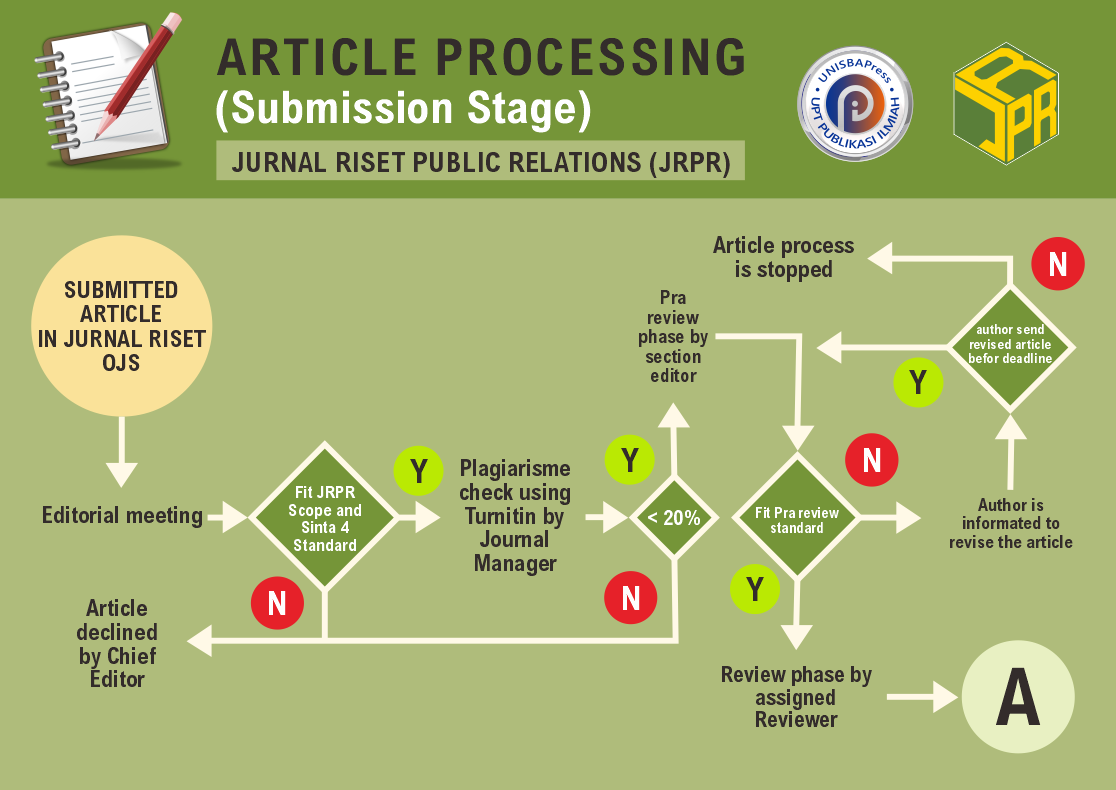Identifikasi Permasalahan Komunikasi Publik Masyarakat Indonesia pada Masa Pandemi Covid 19
DOI:
https://doi.org/10.29313/jrpr.vi.1353Keywords:
Covid 19, Kesehatan, EkonomiAbstract
Abstract. Responding to the Covid 19 Pandemic, the dissemination of information about Covid 19 created a phenomenon of splitting the opinion of the Indonesian people which was divided into two things that each wanted to prioritize, namely Health and the Economy. The Indonesian government agrees that these two things can’nt work alone, but must be sustainable. This condition created a gap that resulted in the Indonesian Government's program in handling Covid 19 and the national economic recovery (KPC-PEN) being hampered. This study aims to identify public communication problems in grassroots communities during the Covid 19 period in order to provide another perspective for the Government of Indonesia in handling Covid 19 and national economic recovery. The study uses public communication theory and propaganda theory in revealing the issues raised. This study uses qualitative method and descriptive analysis approach. Sources of data obtained through literature studies and observations of mainstream media. The results reveal that there are 3 factors that cause the split of opinion, among others, the community is not optimal in consuming scientific information, the massive spread of hoax and dissenting opinions. In addition, the impact of these factors has formed several community groups, including groups who do’nt believe in Covid 19 (denial), groups who accept the existence of Covid 19 but have not been maximal in implementing health protocols and groups that have adapted to Covid 19.
Abstrak. Menyikapi pandemi Covid 19, diseminasi informasi mengenai Covid 19 menciptakan fenomena pembelahan opini masyarakat Indonesia yang terbagi menjadi dua hal yang masing-masing ingin diprioritaskan, yaitu Kesehatan dan Ekonomi. Pemerintah RI menyepakai bahwa kedua hal tersebut tidak bisa berjalan sendiri, namun harus tetap berkesinambungan. Kondisi tersebut menciptakan gap yang mengakibatkan program Pemerintah RI dalam penanganan Covid 19 dan pemulihan ekonomi nasional (KPC-PEN) menjadi terhambat. Penelitian ini bertujuan untuk mengidentifikasi permasalahan komunikasi publik pada masyarakat akar rumput pada masa Covid 19 guna memberikan perspektif lain bagi Pemerintah RI dalam penanganan Covid 19 dan pemulihan ekonomi nasional. Peneliti menggunakan teori komunikasi publik dan teori propaganda dalam mengungkap permasalahan yang diangkat. Penelitian ini menggunakan metode kualitatif dan pendekatan analisis deskriptif. Dengan sumber data yaitu melalui studi kepustakaan dan observasi media mainstream. Hasil penelitian mengungkapkan bahwa ada 3 faktor yang menyebabkan pembelahan opini tersebut, antara lain masyarakat tidak maksimal dalam mengkonsumsi informasi yang bersifat ilmiah, masifnya penyebaran hoax dan dissenting opinion. Selain itu, dampak faktor-faktor tersebut telah membentuk beberapa kelompok masyarakat, antara lain golongan yang tidak percaya Covid 19 (Denial), golongan yang menerima adanya Covid 19 namun belum maksimal dalam menerapkan protokol kesehatan dan golongan yang telah beradaptasi dengan Covid 19.
References
Freberg, K., Palenchar, M. J., & Veil, S. R. (2013). Managing and sharing H1N1 crisis information using social media bookmarking services. Public Relations Review, 39(3), 178–184. https://doi.org/https://doi.org/10.1016/j.pubrev.2013.02.007
Guo, J., Liu, N., Wu, Y., & Zhang, C. (2021). Why do citizens participate on government social media accounts during crises? A civic voluntarism perspective. Information & Management, 58(1). https://doi.org/103286
Krum, R. (2013). Cool Infographics: Effective Communication with Data Visualization and Design (1st ed.). John Wiley & Sons, Inc.
Moleong, L. J. (2013). Metodologi penelitian kualitatif (20th ed.). Remaja Rosdakarya.
Nasution, S., Sadono, D., & Wibowo, C. T. (2018). Penyuluhan Kesehatan untuk Pencegahan dan Risiko Penyakit DBD dalam Manga dan Infografis. Jurnal Penyuluhan, 14(1).
Rahmadiana, M. (2012). Komunikasi Kesehata Sebuah Tinjauan. Jurnal Psikogenesis, 1(1), 88–94.
Sanders, K. B. (2020). British government communication during the 2020 COVID-19 pandemic: learning from high reliability organizations. Communication and Culture, 5(3), 356–377. https://doi.org/10.1080/23753234.2020.1824582
Sastropoetro, S. (1990). Pendapat Umum dan Khalayak Dalam Komunikasi Sosial. Remaja Rosdakarya.
Severin, Werner J. & James W. Tankard, J. (2005). Teori Komunikasi Sejarah, Metode dan Terapan di dalam Media Massa (5th ed.). Kencana Prenada Media Group.
Triyaningsih, H. (2020). Efek Pemberitaan Media Massa terhadap Persepsi Masyarakat Tentang Virus Corona (Studi Kasus; Masyarakat di Pamekasan). Meyarsa Jurnal Ilmu Komunikasi Dan Dakwah, 1(1). https://doi.org/https://doi.org/http://dx.doi.org/10.19105/meyarsa.v1i1.3222
Wicandra, O. B. (2006). Peran infografis pada media massa cetak. Jurnal Nirmana, 8(1), 44–49.















